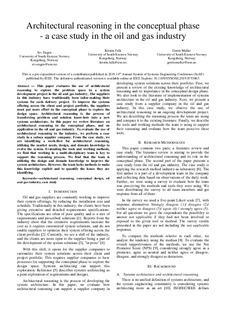Architectural reasoning in the conceptual phase - a case study in the oil and gas industry
Chapter
Accepted version
Permanent lenke
http://hdl.handle.net/11250/2625157Utgivelsesdato
2019Metadata
Vis full innførselSamlinger
Originalversjon
2019 14th Annual Conference System of Systems Engineering (SoSE). 2019, 87-92. 10.1109/SYSOSE.2019.8753863Sammendrag
This paper evaluates the use of architectural reasoning to explore the problem space in a system development project in the oil and gas industry. The suppliers in this industry have traditionally been tailor-making their systems for each delivery project. To improve the systems offering across the client and project portfolio, the suppliers must put more effort in the conceptual phase to explore the design space. Architectural reasoning is the process of transferring problem and solution know-how into a new systems architecture. In this paper we review literature on architectural reasoning in the conceptual phase, and on application in the oil and gas industry. To evaluate the use of architectural reasoning in the industry, we perform a case study in a subsea supplier company. From the case study, we are identifying a work-flow for architectural reasoning, utilizing the market needs, design, and domain knowledge to evolve the system. Evaluating the tools and working methods, we find that working in a multi-disciplinary team is key to support the reasoning process. We find that the team is utilizing the design and domain knowledge to improve the system architecture. However, the team lacks methods to make this knowledge explicit and to quantify the issues they are identifying.
Beskrivelse
This is a pre-copyedited version of a contribution published in 2019 14th Annual System of Systems Engineering Conference (SoSE) published by IEEE. The definitive authenticated version is available online at IEEE Explore: 10.1109/SYSOSE.2019.8753863.
